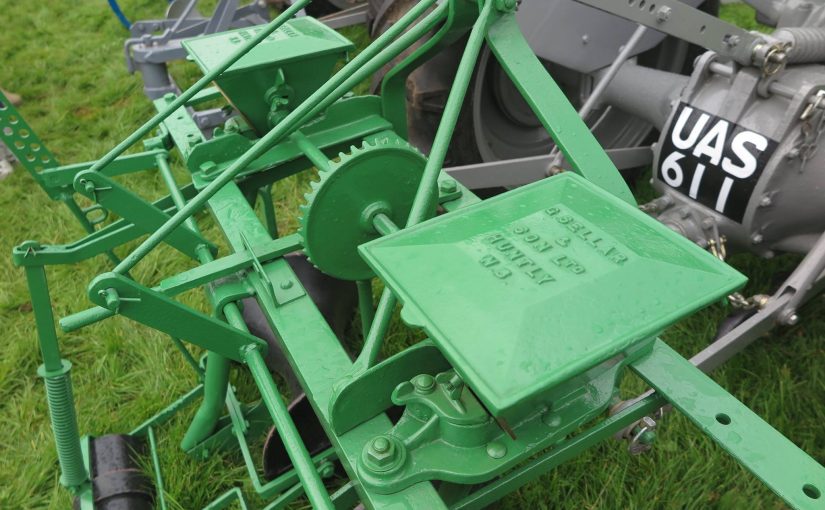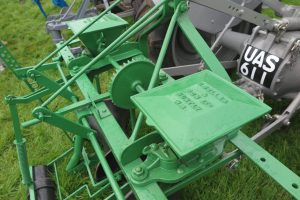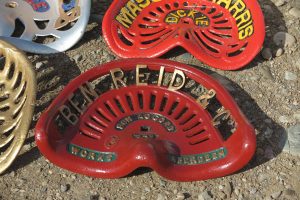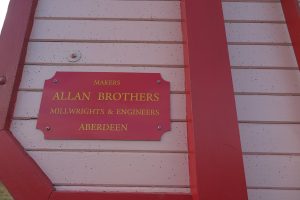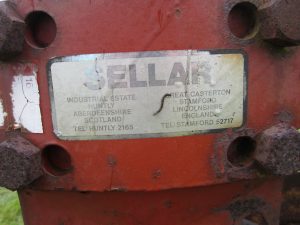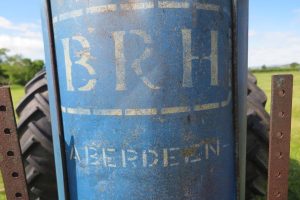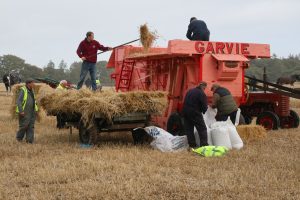The Royal Northern was one of the key agricultural shows in Scotland. It provided an important showcase for agricultural implement and machine makers in the north east and further afield to exhibit their manufactures and those for which they held agencies. The Aberdeen press and journal provided an account of the implement department in its issue of 16 July 1903. It described what was new, innovative and worth a look at the key stands of makers. It is well worth a read for seeing what was on display at that time and to consider how much implements and machines have changed since that date:
“The summer show
At central park at Kittybrewster
The implement department will also possess much interest, and on the various admirably laid out stands one will be able to inspect the implements in their most advanced state of perfection. The plan of the showyard is very much on the same lines as former years, and which experience has proved be the most satisfactory both for exhibitors and visitors.
The implement section
As is invariably the case, the shower of implements comprises a large amount of space of the showyard, and this year there is a great variety of implements and machines on exhibition, showing almost everything that is now and interesting for facilitating and perfecting the work of the farm. We give descriptions of several of the stands, as well as articles of outstanding interest to be found on them.
Ben Reid and Co. Ltd
At stand no. 1, Ben Reid and Co Ltd, of the Bon Accord Works, show a large and varied collection of implements, well finished and tastefully laid out, and well worth inspecting. Occupying a prominent position, on the stand are a number of the Massey Harris binders, well and favourably known all over the United Kingdom. Last year when the crops were extremely difficult to handle the machine did work which enhanced its already brilliant reputation. It is fitted with ball and roller bearings, which make it one of the lightest draught binders in the market. Being most substantially built there is little or no trouble with breakages during harvest, and its durability is shown by the fact that numbers of machines sent out 14 or 15 years ago are still doing as good work as ever. The Bon Accord no. 2 back delivery reaper is also shown on this stand. This reaper is strong and light in draught, and it can, when fitted with mowing show, be used as a mower. The speed of the knife being very high, it makes capital work among hay. Conspicuously displayed are a number of “Diamond” mowers, a mower which was brought out two or three years ago, and in which are embodied several new points. This machine is chain driven, and noiseless when work; it can be fitted with reaping parts and used as a manual reaper if desired. Threshing machines in several sizes form a notable feature. As usual they are well finished. The reputation of the firm for this class of machine is being more than maintained, as we are informed that, although the season has hardly begun, they have already booked a large number of orders. For the hay season are exhibited a collection of horse rakes and hay gatherers which are certainly worth looking at. Other implements on view are a number of “Bon Accord” spring tine cultivators, introduced by this firm about three years ago, and which have been sold in thousands all over the north, drill and broadcast sowers, artificial manure distributors, bruisers, chaff cutters, weighting machines, garden seats, and dairy utensils, etc- all substantial, well-finished goods. This collection is in many respects unique and should not be missed.
Messrs George Bruce and Co
Stand no. 27-George Bruce and Co., seed and implement merchants, 35 Market Street, Aberdeen, occupy one of the largest stands in the showyard. It is situated to the left of the main entrance, and is 200 feet long. Their stand affords one of the fullest displays of agricultural implements in the yard, the exhibit not being confined to any one kind of implement, but being extensive in its character. The attention of the visitor will be first attracted by the firm’s show of the new Albion steel binders, of which there are six forward. They are of the latest type, and embrace the best and up-to-date improvements. The Albion new patent, low down, steel binder, no. 2 is one of the lightest and most compact in the yard, and has given the utmost satisfaction to patrons during the last two years. The driver’s seat being placed low down at the back of the machine he has full command of his horses, and can see at a glance both the cutting and binding gear, and, in case of anything going wrong with the machine, he can pull up his horses at once. Alongside the Albion binders, Messrs Bruce have a capital display of the Albion back-delivery reapers, which are so well known in the north of Scotland that they need no special mention. Messrs Bruce are the sole agents for the Albion binders and reapers. The firm also shows one of H.L. 2 Albion mowers. These machines are fitted with two speeds-one for reaping and the other for mowing. The firm also exhibits one of the Albion H.L. single-speed mowers, two of the Milwaukee mowers, and one Ideal mower. These are very light and well finished mowers, and well worthy of notice. There are also on the stand two Ransome’s horse rakes, two Nicholson’s horse rakes, and three of Ransome’s well-known Scotch ploughs. They also exhibit two baker’s prize vans, also one of Duncan’s and one of Stubbs’ combined barn fans, with elevator and automatic weighing machine. This machine will dress the grain, elevate it into sacks, and weigh it at one operation. There is also a fine collection of dairy utensils, such as Hathaway’s prize churns, the Favourite churns, and Bradford’s butter-workers, in various sizes. There is also a varied collection of general agricultural implements, including weighing machines, hay collectors, portable boilers, drag rakes, reaper rakes, turnip cutters, chaff cutters, cake breakers, corn bruisers, simplex pumps etc. The firm also exhibit a very large display of rustic garden seats, and folding garden seats and chairs in great variety.
The ”Allan” oil engine
On stand no. 8 our local makers, Messrs Allan Brothers, Ashgrove, exhibit a magnificent collection of their well-known “Allan” oil engines, in sizes varying from 5 ½ to 18 brake horse power. The engines are of a new type, combining several very important features not hitherto embodied in any oil engine. A special feature-and one that has proved itself of real undeniable merit-is the safety oil feed, which makes it impossible for a careless or inexperienced attendant to flood the vapouriser and so prevent the engine from starting. Another very fine improvement is the introduction of a new combination self-starter, which is shown at work on the larger engines. This starter can be worked automatically either by the engine itself or by the attendant, and it makes the engine as easily started and managed as a steam engine, and will completely remove the only prejudice which many users of power have to an oil engine of large size. The design, workmanship, and finish of this engine are of a very high standard, and are invariably favourably commented on by all who have a knowledge of machinery, and when the selection of an engine is put into the hands of an expert the choice very often falls upon the “Allan”. The Ashgrove Engineering Works adjoin the showyard, but all the same the Messrs Allan deserve the highest credit for making what is undoubtedly by far the finest exhibition of oil engine seen in Aberdeen, and we have no doubt but that their stand will be of special interest to all who contemplate purchasing an oil engine. We may add that the Messrs Allan have given up the manufacture of gas engines, and are now devoting themselves exclusively to the engine, and are, we believe, the only firm in this country to make a sole speciality of this class of machine.
George Sellar and Son, Huntly
At stand no. 4, George Sellar and Son, Huntly, have a very large exhibition of their own implements, as also of those of Messrs W. A. Wood, London, for whom they have acted as sole agents for many years. The most prominent feature of this exhibit is the display of New Century Binders. The firm had a very large sale for these last year, and, notwithstanding the very stiff ordeal they had to pass through, they turned out well-as is testified ny the lathe book of testimonials which they have received. The binder is strongly built, has roller bearings throughout and has a very large capacity for heavy and tangled crops. There are several new features about the machine; one of them a very simple expedient for slackening the canvasses instantaneously. This enables a farmer, when through working for the night, to relieve the tension on the canvasses. There is again this year a large demand for this binder. There are also shown improved horse rakes and Wood’s celebrated mowers. The outstanding feature of George Sellar and Son’s own manufacture is their own M.P. plough. This is a plough which is fast becoming a universal favourite. Hundreds of them are now in use, and they are being bought by our oldest and most experienced agriculturists. The plough is light, it turns the furrow well, and packs it. It can be used for all kinds of work that any ordinary plough can accomplish about the farm. The device for attaching the moveable point is simple, and not liable to get out of order. They also show samples of their famous no. 27 and 29 ploughs, known all over the north of Scotland. Steel harrows, broadcast turnip sowers, and steel grubbers are also very strongly in evidence. There are also a few oil engines exhibited. Undoubtedly the leading attraction of stand no. 4, as it is sure to be of the showyard, is the Motor Binder, an adaptation of the oil motor to Walter A. Wood’s binder, in two sizes, six and ten feet cut. Not only does this motor binder dispense with the use of horses, but the amount it cuts is about double that cut by a horse-drawn binder; and another great advantage is, that it can be used upon land, not being dependent upon the ground wheel for motive power. The binder can be travelled along without working the knives and claws, and the knives and claws, on the other hand, can be worked when the machine is stationary.
Barclay, Ross and Tough
This well-known firm of implement and seed merchants, and waterproof cover manufacture, occupy the lathe stand at no. 16, situated a little to the left of the main entrance. The feature of the stand is the extensive display of the new light-draught Hornsby binders, fourteen of which have been sold to farmers in the district, and will be drawn by horses from the showyard to-morrow morning, and taken to the farms for which they have been purchased. The binder has been improved upon so as to suit it to northern localities. It has, for instance, been provided with brass and steel bushes in order to prevent it from clogging, and thereby reducing the draught. It has also been suited to deal with light or heavy crops. The object of the firm has been to adapt the binder to suit the vagaries of the weather and the differences of soil to be encountered. This desire, carried into effect, has met with the appreciation of patrons, and a large scale of the binder has been experienced, a great many of then having been sent out last year. The Balmoral plough, which finds a place on the stand, has been proved to be exceedingly useful for the ordinary work of the farm, if not for match purchases. It is a saver of time, and this fact, combined with the circumstance that the plough is light to work, has commenced it to many farmers throughout the north. Among the other implements on the stand are the Albion corn bruisers, with latest improvements, chaff cutters, the Albion new combined bruiser and dibbler, the new patent Albion mowers, with roller bearings and with manual attachments, mowers and reapers combined, horse rakes, and a specimen of the Akroyd engine, which, after a severe succession of trials at the Royal English Show, distinguished itself in the work for which it is adapted. It is used for driving threshing machines, and other implements used on the farm. It is also utilised for the purposes of electric lighting. Indeed, the stand is replete with the newest and most useful implements and machines required for the farm and the forest, and a visit to it should prove interesting, whether the caller happened to be a purchaser or not.
C. F. Wilson and Co
At stand no. 11 C. F. Wilson and Co. show a couple of their well-known oil engines at work, one being of eight and the other of five horse power. During the past year, there has been a great demand for the engines built by this firm, so great that in consequence of foreign and repeat orders, they have not been in a position to supply retail orders. Having lately added to their plant several new labour-saving machines, they are confident of being able to compete with all demands. C. F. Wilson and Co. are at present sending their engines to England, South American, France (mostly to Paris), Capr Town, West Indies, Australia, New Zealand, Egypt, and Portugal. These engines are so very simple that any unskilled labourer can work them. The two engines on exhibition are shown driving two threshing machines.
Robert G. Garvie
Stand no. 11 (Mr Robert G. Garvie’s) will repay a visit. Machines for doing two of the most important farm operations-harvesting and threshing-are on exhibition. The binders and mowers made by the Deering Company are unsurpassed for strength on construction and lightness of draught, and in such grain-growing districts as East Lothian they are supplanting every other binder. Machines of each type are shown, also a new self-acting horse rake, and a new sickle grinder, which is run in ball bearings. Two sizes of threshing machines are shown-one 36 inches wide, driven by an 8bhp oil engine, and one 33 inches wide, driven by a 5 ½ bhp oil engine. The capacity of the former is eight quarters, and of the latter six quarters of finished grain per hour. A glance at these machines will at once show their high finish and substantial workmanship, their lightness and smoothness in running being due to their long bearings and accurate fitting. These threshing machines are made by Mr Garvie in his own works, and such is the demand that he is kept fully employed at them the whole year, and to enable them to cope with the increased orders he has recently put down additional plant of a special-type for this class of work.
Watson Brothers, Banff Foundry
The firm exhibit at stand 17 the “Victory” reaper, which has been considerably improved for season 1903. In addition to brass bearings being substituted in the main bracket for white metal formerly used, the firm have fitted the machines with 21 fingers instead of 19, which will be a decided improvement in the cutting apparatus. The makers claim for the “Victory” that it is the best-balanced back-delivery reaper of its kind in the market. They also exhibit the “Albion” binder and a specially finished threshing machine. A threshing machine built by Marshall, the well-known agricultural engineer, has been sold to Mr John Shirran, Templant Cottage, Auchterless.”
